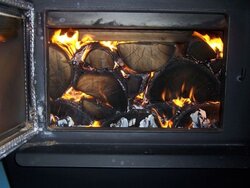Hello,
I haven't posted in a long time. Someone stopped by my house and looked at my wood pile. They said "Are you going to split that." I said "No I like big pieces" he told me that smaller splits burn hotter. I always thought that large pieces last longer. So what do I do. Large pieces or small splits. I heat my house with wood and can never seem to get the house warm enough. I have a two year old Hearthstone Equinox with damper. Also SS liner all the way up the chimney. The stove doesn't get above 450 degrees. Please tell me your thoughts.
I haven't posted in a long time. Someone stopped by my house and looked at my wood pile. They said "Are you going to split that." I said "No I like big pieces" he told me that smaller splits burn hotter. I always thought that large pieces last longer. So what do I do. Large pieces or small splits. I heat my house with wood and can never seem to get the house warm enough. I have a two year old Hearthstone Equinox with damper. Also SS liner all the way up the chimney. The stove doesn't get above 450 degrees. Please tell me your thoughts.


 "Big" splits for some mean different things, how big are we talking about? My big splits are squares or rectangles in the 6x8 or 6x6 category, my favorite sizes are in the 4x6 range but 3x4 or 4x4 make for easy handling.
"Big" splits for some mean different things, how big are we talking about? My big splits are squares or rectangles in the 6x8 or 6x6 category, my favorite sizes are in the 4x6 range but 3x4 or 4x4 make for easy handling.